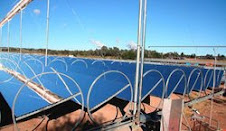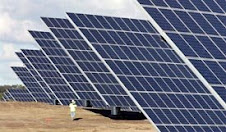Small is beautiful in Congo farming
TheStar.com - World
Officials in the Democratic Republic of Congo fear that the food rioting that has wreaked havoc in 30 other countries will break out in theirs, where, in rural areas, people spend 80 per cent of their household money on food. More than a quarter of the population — some 16 million people — are undernourished.
In this war-torn land, helping people feed themselves is a critical weapon against poverty
July 27, 2008
Mitch Potter, Toronto Star European Bureau
KATUBA, DEMOCRATIC REPUBLIC OF CONGO — A lone voice sings out in Swahili as the women enter the fields, and the call is answered in unison. Suddenly the tiny valley is alive with a delicate weave of joyful harmonies.
Here is one hopeful sliver in the broken heart of Africa.
The source of glee seems almost meagre, but in the lives of the mostly female growers of Katuba, it is everything: these 500 women are singing in praise of their own private green revolution, a turnaround created with deceptive simplicity – handfuls of carefully selected seeds, a few tools and watering cans, access to just enough credit and food aid to get it off the ground. And the result for many is a tripling of farm incomes in a span of three years through raising fresh-for-market garden produce.
Four dollars a day isn't much, not even here in eastern Congo. But it is an uncommon sum, fully double what an estimated 300 million sub-Saharan Africans – including a quarter of the world's hungriest – struggle to attain. Crucially for Katuba, the bounty of Chinese cabbage, spinach, carrots and subtropical greens from these tiny plots translates into belly-filling food security, with enough surplus to keep kids clothed and in school.
"We eat maybe 10 per cent and we sell the rest – even from these small gardens, it works," says Rebecca Tshidibi, 24, who founded Katuba's Association of Women for Integrated Development on 60 hectares of unworked but arable land, with a hidden agenda to mend a community shattered by five years of regional conflict deadlier than any since World War II.
A third of these women are HIV carriers, others are victims of sexual violence and others still are refugees returning from nightmares untold. Everyone ranks as a survivor of a civil war that claimed as many as five million Congolese, most not from bullets or bombs but from diseases that prey on the acutely malnourished.
"The women with the virus, they were isolated and depressed," says Tshidibi. "They had no direction in life. The best part of what we are building is that today they belong. Now, the women with HIV are the core of our project. The success of our garden is making us a community again."
In Katuba and a dozen similar sites visited by the Toronto Star during a two-week journey into some of the most remote parts of eastern Congo, the same grassroots theme arises time and again: when it comes to African agriculture, small is beautiful. Where there are no roads to speak of – and in many parts of Congo, a 100-kilometre journey can eat up an entire day – dramatic investment in helping the population to feed itself is the obvious way forward.
Only now, as skyrocketing food prices expose the neglected state of farming on the continent, are fledgling local governments and the mandarins of global aid coming to the same conclusion. In the Congo alone, the United Nations Food and Agriculture Organization is unfurling $50 million worth of emergency development projects to help unleash the growing potential of smallholder associations like Katuba's.
"Small is beautiful," says Keith Wiebe, a development economist with the FAO. "It is by no means the only answer. But more and more, people are realizing that the really basic inputs – good seeds and fertilizer, access to a little bit of credit – will go a very long way toward restoring food security for Africa."
"It is heartening to see because in the Congo, where agriculture has suffered from decades of inattention, almost nobody uses fertilizer. There is a huge potential there. But it is going to require a huge effort to realize it. And that effort must come to terms with the fact that while small, localized farming desperately needs encouragement, no one answer is going to be a total solution."
In sprawling Congo, projects like the garden at Katuba succeed because the village is only a short distance by bicycle from the deep pockets of boomtown Lubumbashi, the capital of Katanga province, where Chinese-led revival of the mining industry has created a market for fresh produce.
Two bush plane flights away, in the easternmost town of Kalemie, a more desperate situation is apparent in the telltale signs of malnutrition – hungry faces, bloodshot eyes, distended bellies and reddish hair. Here, just across Lake Tanganyika from where Stanley met Livingstone, the Threat Assessment Level billboard at the United Nations peacekeepers' barracks says it all – the needle is set at dead centre, demarking a merely moderate danger of 3 out of a maximum 5.
Not quite crazy enough for war journalists, who bypass the occasional Mai Mai rebel attacks around Kalemie for the substantially more volatile North and South Kivu, where the localized remnants of the Congolese civil war are more easily found.
Yet not quite calm enough for many foreign diplomats and aid workers, including the Canadian contingent, who remain grounded at the other end of the country, in Kinshasa, until such time as Canada is satisfied the Congo has an air carrier that can be trusted not to fall out of the sky.
Outside the town's underused airstrip, a faded sign still proclaims this to be Albertville – the name it wore 50 years ago, when Kalemie was under the especially brutal rule of colonial Belgium. Walking through the main road that binds Kalemie's 109,000 souls together, one is struck with the impression that not much else has changed since then.
One encounters an especially grim scene at the Kalemie Nutritional Centre, where mothers and babies arrive at the rate of 50 a month, often on the verge of death. Under mosquito netting, the children drink medicated milk delivered by UNICEF, while the mothers are fed by the World Food Program. Outside, the parents who survive attend an FAO-sponsored gardening school while their infants recuperate.
"It is revelation to me that in just three weeks you can raise something to eat from the ground," says Guylane Fatuma, 45, a widowed mother of six, as she harvested fistfuls of amarante, a bitter African green similar to spinach.
Fatuma will leave the centre after 30 days with 40 grams of seeds – enough to grow 2,000 plants, along with a watering can and a machete. But she is circumspect about her prospects for making a go of it.
"I have learned not to hope for too much," she says. "During the war the soldiers stole our animals, and we were down to eating the peels of the cassava. We had to send the older children out to find food even when it was dangerous, to keep from starving."
A similar story is told by Georgette Mwaijuma, 32, a mother of seven, who was resettled in a village near Kalemie after spending seven years in the bush with the Mai Mai militia. Her job was to make fetishes – good luck charms worn about the waist as protection against bullets.
"We would tie them around our bellies – they were authentic, they worked," she remembers with pride. Today she is assigned to a single-room, mud-brick hut without water or electricity, scrounging to feed her seven children. She has four goats and a small patch on which to grow.
"My life is unhappy. It is still very difficult. I have many children, and they are in bad shape. If God wants, things will get better, but I don't know if God is going to bless us."
Pierre Mwambe, 28, joins the conversation, offering a variation on the theme. He spent five years in the bush with the Mai Mai rebels, but as a captive forced into battle. And when the militia group discovered he was able to read and write, Mwambe was placed "in charge of administration." His ordeal ended with a bullet from a competing militia. He wasn't wearing any protection – "I don't believe in fetishes," he says. Others nearby nod knowingly, as if this explains all.
"I did administration for the Mai Mai," continues Mwambe, who is raising goats and produce on his small patch. "Now I would like to go back to school and study public administration to help the government. I can see our country needs good administrators."
In Kinshasa, government officials readily acknowledge their moral responsibility to pay more than lip service to the farming sector. Only by sheer accident has the Congo managed to thus far avoid the food riots that have wreaked havoc in some 30 other countries, according to Thomas Emboli Jejune, the country's deputy minister of agriculture.
Full story continues at: HIV carriers and rape victims in Congo become successful farmers
NUMBERS TELL STORY OF AFRICA'S ECONOMIC CHALLENGES
50.73
Estimated average life expectancy in sub-Saharan Africa as measured by the UN Population Division. That represents a longevity increase of 4 per cent from five years ago.
5
Percentage share of total aid to Africa that is channelled into agricultural development.
2
Factor by which $1 of agricultural growth reduces poverty compared to $1 of growth in non-agricultural sections, according to the 2008 World Bank Development Report
50
Poverty rate, in percentage, among inhabitants of sub- Saharan Africa, a figure unchanged in 10 years and that today represents 228 million people, World Bank estimates.
25
Productivity, in percentage, of Africa's neglected farming sector, which employs more than half the workforce, compared to global average.
96
Percentage of African agriculture dependent entirely on annual rainfall, a figure that is driving an emphasis toward drought-resistant-seed science.
50
Percentage of sub-Saharan Africans who live in small, landlocked countries, where transportation costs for imported food are 50 per cent higher than for coastal residents.
575
Cost to Japan, in millions of dollars, to host the Group of Eight summit. Oxfam estimates this would translate into a year's worth of treatment for 4 million HIV sufferers.
How to help Congo's women? Visit: Youreworthit.org - Congo Women Rebirth Through Healing
Peace 2 All!
Best Green Stocks Investing Blog
Subscribe to:
Post Comments (Atom)
Yuya Joe Blog
Lake Ontario Waterkeeper
The Daily Beast -Politics Blog
21stArch.com - 21st Century Architecture
Original Joe College Blog
WikiLeaks Foreign Policy Analysis
AGreenRealtor.com Real Estate Blog - Ecology Energy Efficiency
Best Green Stocks Investing Blog
PV Intell Photovoltaic Solar Stocks Investing
SEARCH Leading Alternative Energy and Ethical Investing websites

Custom Search
Daily Kos
Rare Earth Stocks Research
Patrick MacManus's Blog Peace and Collaborative Development
BeesTreesFrogsElephants.com - Nature and Ecology Blog
Research Green Energy stocks, Clean Energy investing information
Find wind power investing info online, clean energy mutual funds, geothermal stocks, solar energy investments.

Green Energy Investing Network:
Green Stocks Investing Clean Power Blog
SolarIntell.com Renewable Power Investing Website
Wind Intell.com Wind Energy Stocks Company Links
Geothermal Power Investing Public Companies
PV Intell.com Leading Photovoltaic Solar Energy Stocks

Custom Search
Green Energy Investing Network:
Green Stocks Investing Clean Power Blog
SolarIntell.com Renewable Power Investing Website
Wind Intell.com Wind Energy Stocks Company Links
Geothermal Power Investing Public Companies
PV Intell.com Leading Photovoltaic Solar Energy Stocks





No comments:
Post a Comment